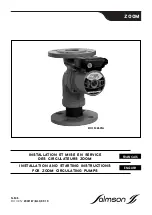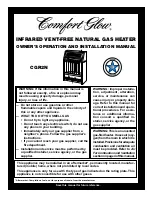
22
When checking the Temperature-Pressure Relief Valve operation,
make sure that (1) no one is in front of or around the outlet of the
Temperature-Pressure Relief Valve discharge line, and (2) that the
water discharge will not cause any property damage, as the water
may be extremely hot. Use care when operating valve as the valve
may be hot.
To check the relief valve, lift the lever at the end of valve several times,
see Figure 21. The valve should seat properly and operate freely.
If after manually operating the valve, it fails to completely reset and
continues to release water, immediately close the cold water inlet
to the water heater and drain the water heater, see Draining And
Flushing on page 24. Replace the Temperature-Pressure Relief Valve
with a properly rated/sized new one, see Temperature-Pressure
Relief Valve on page 11 for instructions on replacement.
DISCHARGE PIPE
TEMPERATURE-PRESSURE
RELIEF VALVE
FIGURE 21.
If the Temperature-Pressure Relief Valve on the water heater weeps
or discharges periodically, this may be due to thermal expansion.
NOTE:
Excessive water pressure is the most common cause of
Temperature-Pressure Relief Valve leakage. Excessive water
system pressure is most often caused by “thermal expansion”
in a “closed system.” See Closed Water Systems and Thermal
Expansion on page 11. The Temperature-Pressure Relief Valve
is not intended for the constant relief of thermal expansion.
Temperature-Pressure Relief Valve leakage due to pressure
build up in a closed system that does not have a thermal
expansion tank installed is not covered under the limited
warranty. Thermal expansion tanks must be installed on all
closed water systems.
DO NOT PLUG THE TEMPERATURE-PRESSURE RELIEF
VALVE OPENING. THIS CAN CAUSE PROPERTY DAMAGE,
SERIOUS INJURY OR DEATH.
Explosion Hazard
Temperature-Pressure Relief Valve
must comply with ANSI Z21.22-
CSA 4.4 and ASME code.
Properly sized temperature-
pressure relief valve must be
installed in opening provided.
Can result in overheating and
excessive tank pressure.
Can cause serious injury or death.
RECOMMENDED PROCEDURE FOR PERIODIC
REMOVAL OF LIME DEPOSITS FROM TANK TYPE
COMMERCIAL WATER HEATERS
The amount of calcium carbonate (lime) released from water is
in direct proportion to water temperature and usage, see chart.
The higher the water temperature or water usage, the more lime
deposits are dropped out of the water. This is the lime scale which
forms in pipes, heaters and on cooking utensils.
INSTALLED IN SUITABLE AREA: To insure sufficient ventilation
and combustion air supply, proper clearances from the water
heater must be maintained. See Facts to Consider About The
Location section. Combustible materials such as clothing,
cleaning materials, or flammable liquids, etc. must not be placed
against or adjacent to the water heater which can cause a fire.
ANODE ROD INSPECTION
Property Damage Hazard
•
Avoid water heater damage.
•
Inspection and replacement of anode rod required.
CAUTION
The anode rod is used to protect the tank from corrosion. Most hot
water tanks are equipped with an anode rod. The submerged rod
sacrifices itself to protect the tank. Instead of corroding the tank,
water ions attack and eat away the anode rod. This does not affect
water’s taste or color. The rod must be maintained to keep the tank
in operating condition.
Anode deterioration depends on water conductivity, not necessarily
water condition. A corroded or pitted anode rod indicates high water
conductivity and should be checked and/or replaced more often than
an anode rod that appears to be intact. Replacement of a depleted
anode rod can extend the life of your water heater. Inspection should
be conducted by a qualified service technician, and at a minimum
should be checked annually after the warranty period.
Artificially softened water is exceedingly corrosive because the
process substitutes sodium ions for magnesium and calcium ions.
The use of a water softener may decrease the life of the water
heater tank.
The anode rod should be inspected after a maximum of three years
and annually thereafter until the condition of the anode rod dictates
its replacement.
NOTE:
Artificially softened water requires the anode rod to be
inspected annually.
The following are typical (but not all) signs of a depleted anode rod:
• The majority of the rods diameter is less than 3/8”.
• Significant sections of the support wire (approx. 1/3 or more of
the anode rod’s length) are visible.
TEMPERATURE-PRESSURE RELIEF VALVE TEST
Burn hazard.
Hot water discharge.
Keep clear of Temperature-
Pressure Relief Valve
discharge outlet.
It is recommended that the Temperature-Pressure Relief Valve
should be checked to ensure that it is in operating condition
every 6 months.














































